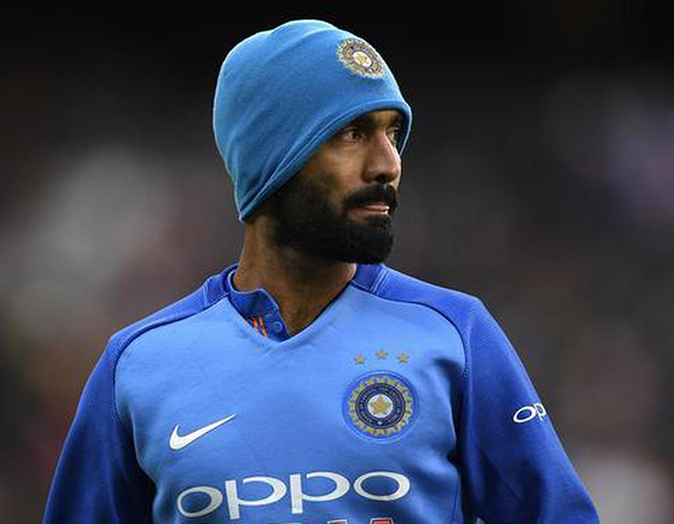Registered with the Registrar of Newspapers for India under R.N.I 53640/91
Vol. XXXII No. 7, July 16-31, 2022
Dinesh Karthik’s Never-say-die Career – An Inspiration
-- by Partab Ramchand
At an age when most cricketers are retired or at least contemplating retiring, Dinesh Karthik is playing the best cricket of his career. It is not easy for a 37-year-old to excel in T-20 which is fast becoming the young player’s prerogative – it is to the credit of the Chennai-born wicket keeper batsman that he is not only commanding a place in the shortest format, but has also enhanced his reputation as a ‘finisher.’
Anyone else in Karthik’s situation might well have called it a day. He made his international debut around the time that M.S. Dhoni appeared on the scene and the manner in which the latter sealed his place in the side purely on merit meant that the doors were closed to Karthik. He continued to play first class cricket with distinction, his batting and keeping both being eye catching. One can never forget his acrobatic leg side stumping off Harbhajan Singh to get rid of England captain Michael Vaughan on his ODI debut at Lord’s in 2004. And while his work behind the stumps continued to be of a high order, it was his batting that kept improving by leaps and bounds. But could he make it back to the Indian squad, especially with competition creeping up from a couple of younger stumpers, besides Wridhiman Saha and Parthiv Patel?
But the selectors could not turn the other way when his dynamism with the bat turned to devastating effect, especially in the shorter formats. Batting with absolute freedom and playing the kind of unorthodox strokes from reverse sweeps to switch hits that can turn games on their head, Karthik emerged as a match winner. Even with Dhoni and other keepers around, he now transformed himself into a specialist late order batsman and virtually succeeded Dhoni as a ‘finisher supreme’ who was unstoppable in the death overs, whether India batted first or chased a formidable target.
 Dinesh Karthik. Picture courtesy: The Hindu.
Dinesh Karthik. Picture courtesy: The Hindu.Actually, he displayed this quality in the very first T-20 India played in 2006. In pursuit of a target of 127, India got into a bit of a tangle when Dhoni got out and they were 71 for three in the 12th over. Karthik came in and immediately took charge, with the result that India were home with six wickets and a ball to spare; Karthik’s contribution was an unbeaten 31 off 28 balls with three fours and a six, bagging him the man of the match award.
Though he has displayed his skills abundantly in ODIs, the focus right now is on T-20 cricket; here too, even in the face of stiff competition, Karthik has made himself among the first names in the selectors’ list. The Indian head coach Rahul Dravid said that “Karthik is banging the doors down,’’ adding that his recent performances opens up options for his long term international prospects. Dale Steyn is convinced that Karthik should be a certainty for the World Cup. “You play cricketers who are in form, and on current form, he has stolen a march over Rishabh Pant’,’ says the former South African speedster. Former Indian opener Wasim Jaffer termed his 55 in the fourth ODI against South Africa at Rajkot as a ‘masterclass’ in the manner he turned around a floundering Indian innings into a situation in which India won the match comfortably. South African spinner Keshav Maharaj is of the view that Karthik is one of the best finishers in world cricket today. Perhaps his most famous innings in this format would still be his unbeaten 29 off just eight balls with two fours and three sixes, while steering India to victory over Bangladesh in the Nidahas Trophy tri-series final at Colombo – a six he hit off the last ball clinched the issue. Then again, there have been several little gems in his CV.
Though he is remembered these days more for his pyrotechnics in the shorter formats of the game, it should not be forgotten that Karthik has played 26 Tests over a 14-year-period, scoring just over 1000 runs at an average of 25 with a hundred and seven fifties. Indeed, when it comes to longevity in Indian cricket, he has few equals. For example, he is in his 18th year in international cricket, having played his first ODI in 2004; as for T-20 internationals, he has the third longest career – just behind West Indians Dwayne Bravo and Chris Gayle – having played his first such game against South Africa at Johannesburg in 2006. Basically, his has been a story of the never-say-die attitude and he has been suitably rewarded. His career is an inspiration to cricketers worldwide.

